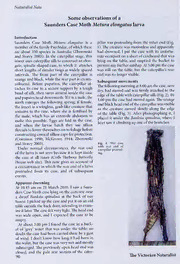
Some Observations of a Saunders Case Moth 'Metura elongatus' Larva PDF
Preview Some Observations of a Saunders Case Moth 'Metura elongatus' Larva
NaturalistNote Some observations ofa Saunders Case Moth Metura elongatus larva Introduction Saunders Case Moth Metura elongatus is a pillar was protruding from the other end (Fig. memberofthefamilyPsychidae,ofwhichthere 1). Thecreaturewas motionlessand apparently are about 350 species in Australia (Zborowski had drowned. 1 put the case with its unfortu- and Storey 2003). In the caterpillar stage, this nate occupant on asheetofcardboard thatwas insect usescaterpillarsilktoconstructanelon- lying on the table, and emptied the bucket to gate, spindle-shaped case, to which it attaches preventanyfurthermishap.At5.00pmthecase short lengths ofslender twigs at widely spaced was still on the table, but the caterpillar’s rear intervals. The front part of the caterpillar is end was nolongervisible. orangeand black, while the rearpart iscream- Subsequentmovements coloured. Before pupation, the caterpillar at- Thefollowingmorningat8.00amthecase,now taches its case to a secure support by a tough dry, had moved and was firmly attached to the band ofsilk, then turns around inside the case edgeofthetablewithcaterpillarsilk(Fig.2). By andpupatesheaddownwards.Ifitisamale,the 1.00 pm the case had moved again. The orange moth emerges the following spring; if female, andblackheadendofthecaterpillarwasvisible the insect is a wingless, grub-like creature that as the creature moved slowly along the edge atrmhenaemdkaemiwanlhtsehei,isnnwphttoihhsecseihcblalhaserae.,vsaEweaghngehsraexteatcrehesnhsleitalhiieedsyafiebnurdtstieohlmiesseeicndlaksbeteyno, polalftaetcrheesdatiwatbiultencdl(eiFrimgb.tihn3e)g.BuaApnfktoesnrieapohsfpoittnhoueglrborsaaap,nhciwhnheges.rite, I1 threadstolowerthemselvesontofoliagebefore constructingconical silkencapsforprotection. (Common 1990; McKeown 1944; Zborowski and Storey2003). Fig. 1. Wet case Under normal circumstances, the rear end with rear end of caterpillar protrud- ofthelarva is not seenbecauseit is kept inside ing. the case at all times (Coffs Harbour Butterfly House web site). This note gives an account of acircumstance inwhich the rearend ofa larva protruded from its case, and of subsequent events. Apparentdrowning At 10.45 am on 21 March 2010, I saw a Saun- dersCaseMothcaselyingontheconcretenear a dwarf Banksia spinulosa at the back of our house. I picked upthecaseand put itonanold tableoutsidethebackdoor, intendingtoexam- ineitlater.Thecasefeltverylight.Theheadend was wide open, and I expected the case to be empty. At about 3.00 pm I found the case in a buck- et of‘grey’ water that was under the table: no doubt thecasehadbeen carriedtherebyagust ofwind. I don’t know how long it had been in thewater, butthecasewasverywetand mostly Pi submerged. The previouslyopen head end was closed, and the pale rear section of the cater- TheVictorianNaturalist 90 NaturalistNote On 28 March I discovered that the caterpil- by no means certain because these caterpillars larhadclimbed apole ofthepatio close to the are frequently parasitised by flies and wasps Banksia. I watched it proceed up to the laserl- (Brewsteretal. 1920).Acasecontainingalarva iteroof, whereitlostitsgrip andfell off. Again that diedbefore completingpupation is shown theheadendofthecasewasopen, andthecat- in the lower figure on the back cover. In this erpillar was not visible, so I suppose this was instancethecauseofdeathisnotknown. a repeat of what had happened before I first The only other Saunders Case Moth larva I found it. On 29 March the caterpillar, possibly haveseen in ourgardenwashereinJune 1992, exhaustedfromits ordeal, nextoptedto secure alsonearourdwarfBanksiaspinulosa. itselfin a position about halfway up the pole. References It remained there for eight months, emerg- BrewsterMN,BrewsterAAandCrouchN(1920)Lifestories ing as an adult male moth on the night of30 ofAustralianinsects.(DymocksBookArcade:Sydney) November. CofFs Harbour Butterfly House web site http://Iepidoptera. butterflyhouse.com.au/psyc/elong.html Discussion Common, IFB (1990) MothsofAustralia. (MelbourneUni- versityPress:Melbourne) Thecaseinwater McKeown KC (1944) Australian insects: an introductory I wondered how the caterpillar had managed handbook. (RoyalZoologicalSocietyofNewSouthWales: Sydney) to survive in the water. Ian Endersby (pers. QueenslandMuseum factsheets web sitewww.qm.qld.gov. cspoimramc.le)s.suIgdgoens’ttedknthoawthitowwoullodnghaavneicnlseocstedcaitns ZbAaouurs/otirwnasqlkiuiai.rPy2/nafdnadcetdSsnth.oere(etRyse/eRcda(Ns2ee0_0wm3o)HtohAlsl_fa2ine0dl0d:8g0Su7yi0dd9n.eepytd)ofinsectsin dothisbeforeithastobreathe. Perhapsthecat- erpillar used its rear end to block the opening inthecaseandpreventwaterfromentering? VirgilHubregtse 6SanikyStreet Sizeofthecase NottingHill,Victoria3168 CasesoffemaleSaunders CaseMothsare 12 to 15 cm long (Queensland Museum fact sheets web site), and are larger than those of males. This case was 9.5 cm long, not counting the length ofthe sticks. A part ofthe abandoned case is shown in the upper figure on the back cover. This creature was fortunate; success is Fig.2.Caseattachedtotablewithcaterpillarsilk. Fig.3.Larvamovingalongedgeoftable. Voll28 (2) 2011 91 S-W3G
